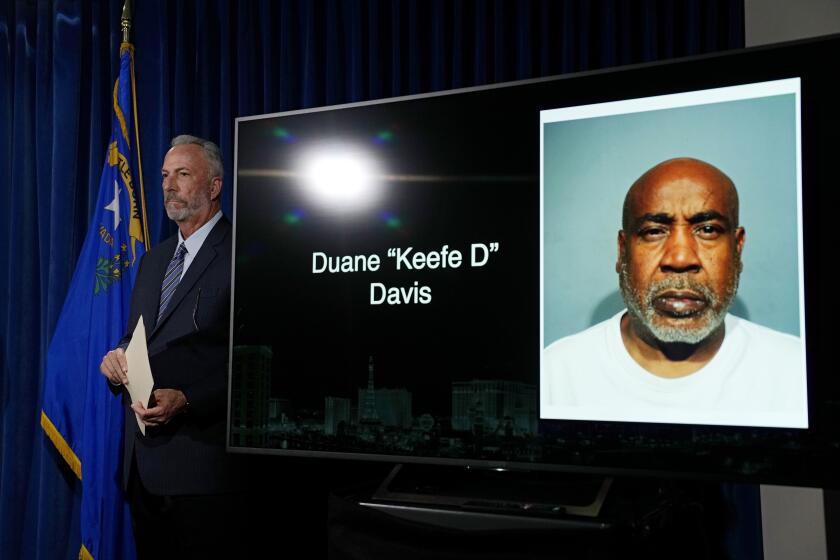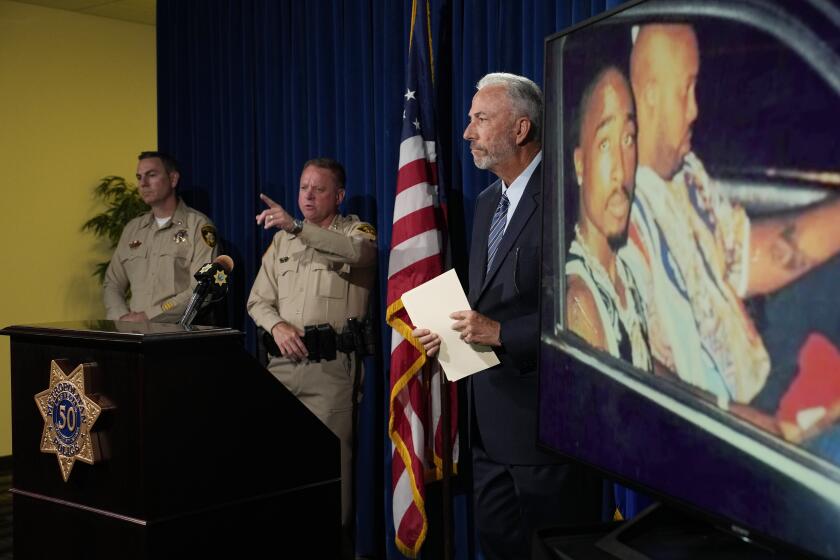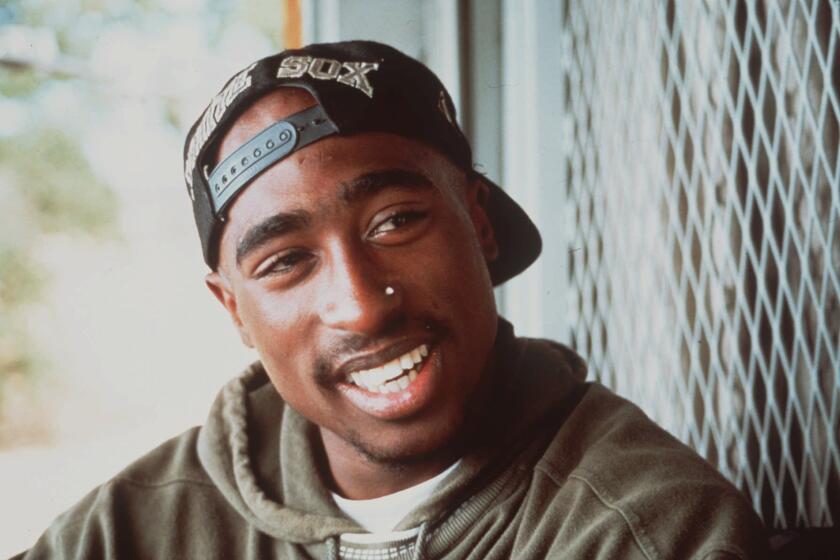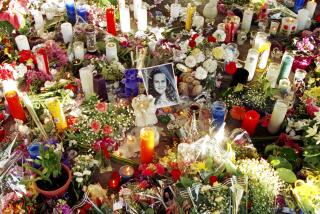Suspect in Tupac Shakur’s killing, an admitted Crips ‘shot caller,’ won’t face the death penalty
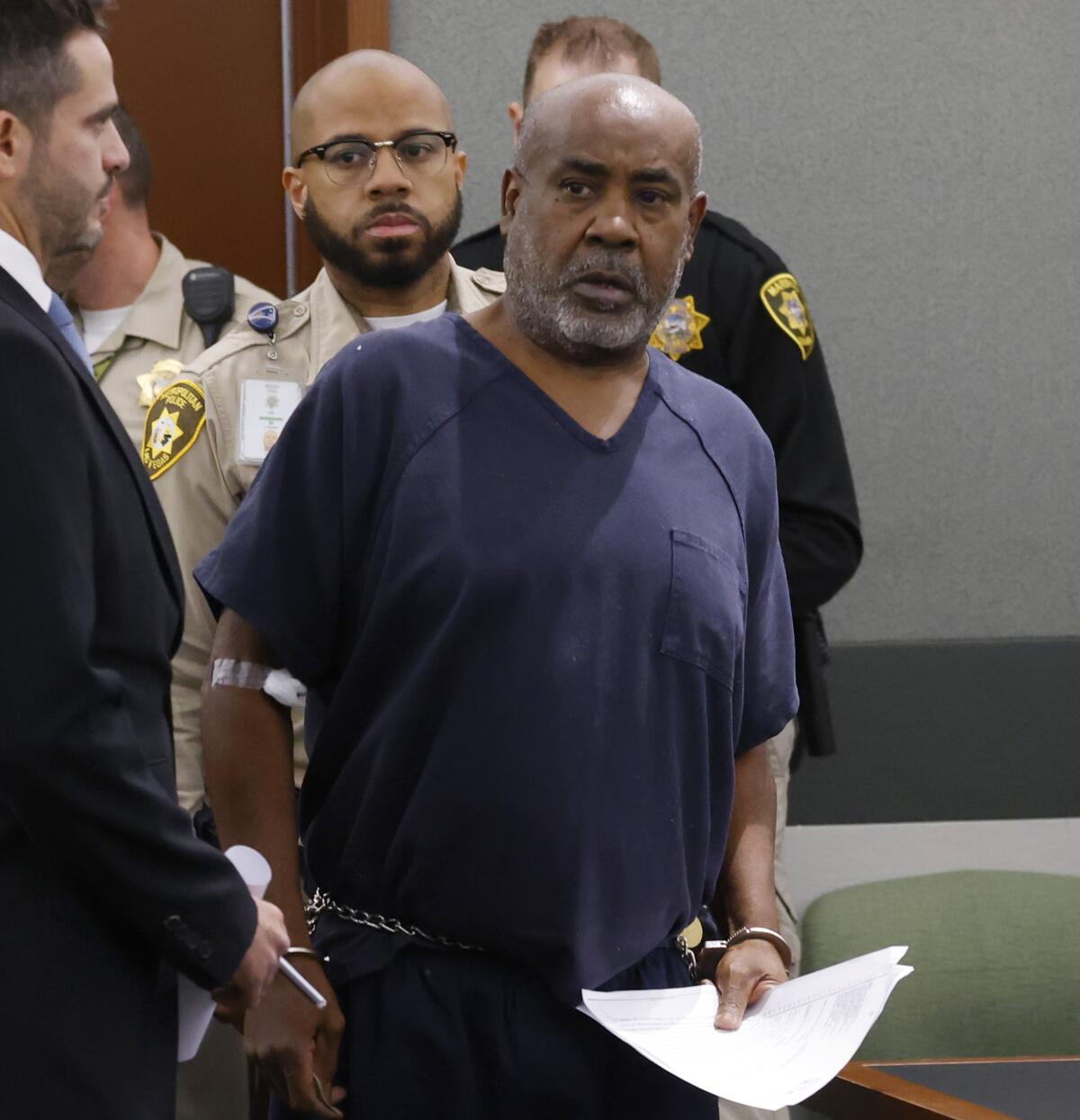
- Share via
Prosecutors won’t seek the death penalty against the man accused of orchestrating the killing of Tupac Shakur, they told a Las Vegas judge Thursday as Duane “Keffe D” Davis pleaded not guilty to murder.
Davis, 60, a self-admitted shot caller of the Compton Southside Crips, appeared in court handcuffed and told the judge he understood the charge he faced. He then entered his plea on his third court appearance since his late September arrest in one of the nation’s most infamous celebrity murder cases.
After Clark County Judge Tierra D. Jones asked prosecutors whether they would seek the death penalty against Davis in the 1996 slaying, a prosecutor said they were not planning to ask a review panel to consider such a move.
Davis asked the judge to explain what she meant by the question.
“Every first-degree murder case, I have to ask the state if they are going to commit to going to committee to seek the death penalty,” Jones said.
Davis was represented Thursday by special public defenders Robert Arroyo and Charles Cano. Two weeks ago, Jones had delayed his arraignment while a new lawyer, Ross Goodman, sought to take over legal representation. Though no agreement has been reached, Davis told Jones he still intended to have Goodman represent him.

The judge set a next appearance for Nov. 7.
Clark County Dist. Atty. Steve Wolfson told reporters after Thursday’s hearing that prosecutors had talked about the death penalty and determined it was not a case in which they would seek it. Wolfson said he believed the trial would start sometime next year.
Following Davis’ last appearance, Goodman, the son of former Las Vegas Mayor Oscar Goodman and current Mayor Carolyn Goodman, suggested police had no evidence beyond Davis’ stories and questioned how authorities could verify his recounting of his involvement in the deadly confrontation on Sept. 7, 1996.
“As everyone here knows, you have to corroborate those statements. You don’t have a car, you don’t have a gun and you don’t have witnesses to corroborate with what Mr. Davis said under those circumstances,” Goodman said. “I believe there is an obvious defense to that — why he made those statements and a motive for making those statements.”
Duane ‘Keffe D’ Davis remains in custody on an indictment of murder, accused of organizing the killing of Tupac Shakur. But his lawyer says authorities have nobody to verify the tales of his involvement.
Prosecutors say Davis, who was indicted by a grand jury on a charge of murder with a firearm, didn’t pull the trigger but provided the gun and encouraged the killing as revenge for a beating that his nephew Orlando Anderson had received at the hands of Shakur, Death Row Records head Marion “Suge” Knight and others affiliated with the Mob Piru Bloods at the MGM Grand Hotel hours earlier.
Knight was driving Shakur in a BMW near the Las Vegas Strip when a white Cadillac pulled alongside them and a gunman opened fire on Shakur, according to police and court records. Knight and Davis are the only living witnesses.
Authorities have said some of the most compelling evidence against Davis comes from the suspect himself.
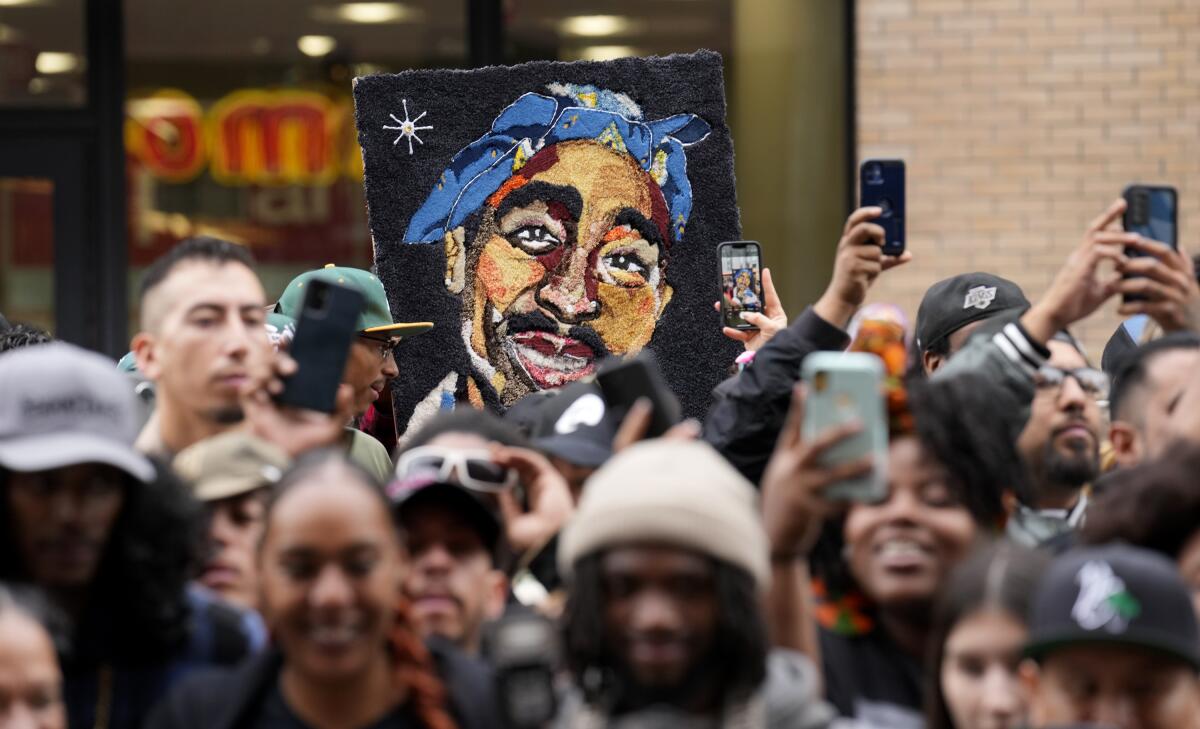
Davis identified Anderson as the shooter in 2008 when he finally talked to authorities with the protection of a proffer from the Los Angeles Police Department and the FBI, meaning his statements could not be used against him. In that interview, then-LAPD Det. Greg Kading asked whether Anderson, a.k.a. Baby Lane, had pulled the trigger.
Shakur “leaned over, and Orlando rolled down the window and popped him,” Davis replied. “If they would have drove on my side, I would have popped them. But they was on the other side.”
When Kading and the LAPD’s Daryl Dupree interviewed Davis in December 2008, they were seeking to solve the 1997 slaying of rapper Christopher Wallace, or “The Notorious B.I.G.,” also known as Biggie Smalls. The proffer information could not be used to charge Davis, but his statements since were part of the evidence presented to the grand jury this year.
In his 2019 memoir and in several interviews, Davis admitted to riding in the car from which the fatal shots were fired at the Los Angeles hip-hop legend. Davis was taken into custody Friday morning.
Davis wanted to make money off Shakur’s death, prosecutors said, and “talked himself into a corner” since the police interview. He believed he still had immunity, as recently as 2022 telling YouTube account Cam Capone News that it was the only reason he was not in custody for Shakur’s killing.
He would repeat the story he told Kading in a series of internet and blog interviews. But in his 2019 book, “Compton Street Legend,” Davis began to change the narrative.
“Tupac made an erratic move and began to reach down beneath his seat,” Davis wrote. “It was the first and only time in my life that I could relate to the police command, ‘Keep your hands where I can see them.’ Instead, Pac pulled out a strap, and that’s when the fireworks started. One of my guys from the back seat grabbed the Glock and started bustin’ back.”
Anderson, who was killed in a gang shootout in Compton a year and a half after Shakur’s death, was long considered the gunman; The Times identified him as such in 1998. At the time of Shakur’s shooting, he was in the back of the Cadillac with DeAndre “Big Dre” Smith, who died in 2004. Davis was in the front passenger seat, he has said, and the car was driven by Terrence “Bubble Up” Brown, who died in a 2015 shooting at a medical marijuana dispensary in Compton.
How Tupac Shakur’s killing in 1996 brought “10 days of hell” to Compton, with multiple shootings that helped crack the case.
After the Las Vegas shooting, Compton police saw “10 days of hell,” according to Robert Ladd, a former Compton detective who investigated Shakur’s death and the retaliatory killings that spiraled from it. By its end, three people were dead and 10 were wounded.
Solving Shakur’s killing was not the responsibility of the Compton police. But an informant drew a line from Shakur’s fatal shooting to a fight that broke out two months earlier at the Lakewood mall, saying a Mob Piru Blood named Travon Lane was shopping at a Foot Locker when some Southside Crips confronted him and took his Death Row necklace.
After watching Mike Tyson knock out Bruce Seldon at the MGM Grand on the night of Sept. 7, 1996, Shakur and his entourage spotted a lone Southside Crip in the casino’s lobby, the source told detectives. Lane recognized him as one of the men who stole his necklace and pointed him out to Shakur, who had recently inked “MOB” on his arm, the informant said.
That Crip was Anderson, according to Chief Deputy Dist. Atty. Marc DiGiacomo, who said Shakur’s entourage launched “a giant beat-down of Mr. Anderson.”
Nearly three decades ago, Tupac Shakur was riding in a BMW driven by Death Row Records boss Marion “Suge” Knight.
In clips of Kading’s interviews that were played for the grand jury, Davis said he and his crew sought retaliation for Anderson’s beating by going to Club 662, which was owned by Knight, to wait for Shakur, but they left when the rapper didn’t show. Then, while driving away, they saw Shakur stick his head out of a car after some girls yelled his name.
“If he wouldn’t even have been out the window, we would have never seen him,” Davis said.
In subsequent interviews, Davis would repeat his account from the proffer interview and describe how his crew came upon Shakur’s entourage: They hit a U-turn and then “boom boom.”
Davis later bragged how the four men “started drinking” after they drove away. Two people associated with the Southside Crips testified to the grand jury in August that they believed Smith was the shooter. One said Anderson could not have gotten off the shot from his position in the back seat of the Cadillac.
Prosecutors wouldn’t identify the shooter, saying only that Davis handed the gun to one of the two men in the back seat. “A lot of people bragged they shot Tupac; we know the reality,” Kading said.
Under Nevada law, prosecutors need only show that Davis aided and abetted the killing of Shakur. During a July search of his Henderson, Nev., home, investigators seized dozens of photos and other memorabilia related to the hip-hop artist’s slaying.
Since his arrest last month, Davis remains in custody in Nevada.
More to Read
Sign up for Essential California
The most important California stories and recommendations in your inbox every morning.
You may occasionally receive promotional content from the Los Angeles Times.
